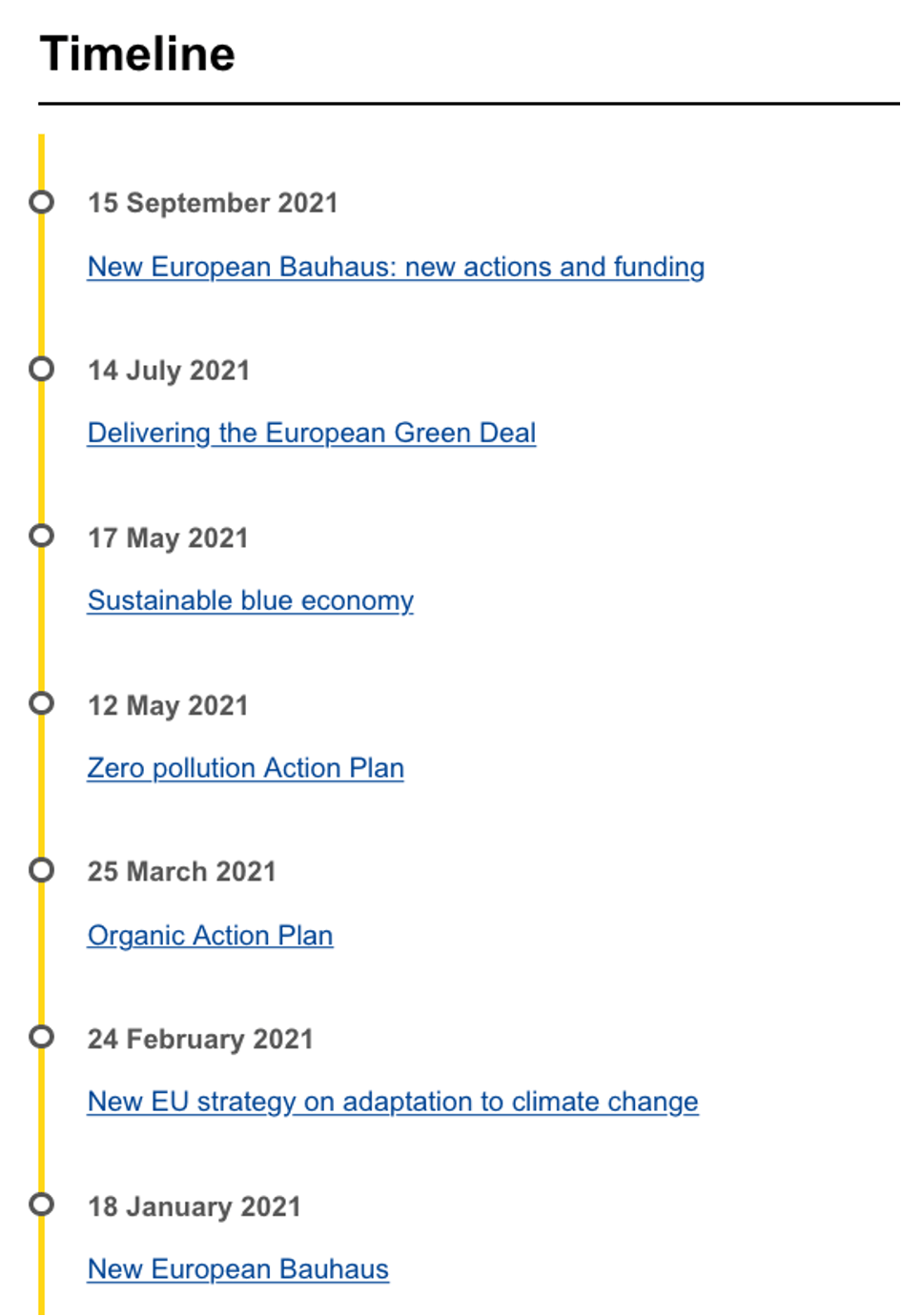Sustainable Germany (7): Green Deal and Leipzig Charter - EU governance of sustainable development
Having the European Union as an additional level of governance may sound like an extra burden for citizens and national governments. It sometimes indeed is a burden but having once agreed on a common set up policies, rules and regulation (the so-called acquis communautaire) among the 27 member states of the European Union (EU) reduces barriers in day-today- life. For instance, having one currency, no internal borders (Schengen agreement) makes travel for leisure and business between companies in Europe easier.
Climate and sustainability policy and related governance are work in progress at the level of the European Union but due to the many different instruments developed it can be inspirational for other countries. This blog post will demonstrate, the EU does have regulatory powers and related financial incentives but only in selected policy fields. In all other fields including foreign policy, security, climate and sustainability policy the EU policies depends a lot more on voluntary cooperation and negotiated agreements. The upside of this is that climate and sustainability policies of the Union are not 'ordered from Brussels'. Instead, they have to be developed in an iterative process involving the European Council, European Parliament, European Commission, Committee of the Regions, other EU bodies, national and subnational governments.
As manager of a EU funding programme with 18 participant EU member states and neighbouring countries I experienced myself for many years that the EU has its issues with bureaucracy and at times there is a lack of coherence. The EU Community Intiative Interreg IIIB in the Central, Adriatic, Danubian and South-eastern European Space (CADSES) showed alreday between 2002 and 2008 many of the conflict lines which exist today between North and South, East and West within the Union. However, I also learned that the convening power of the EU and its regulatory and financial instruments have a major impact on development in member states. For the field of climate and sustainability policy this means that EU policies, their governance and tools -if done properly- could become key in the European transformation process towards climate resilience and sustainability.
Sources for EU Community Initiative INTEREG IIIB CADSES:
https://ec.europa.eu/regional_policy/en/atlas/programmes/2000-2006/european/interreg-iii-b-cadses
https://www.researchgate.net/publication/281318699_Advancing_Trasnational_Cooperation_INTERREG_III_B_CADSES_-_Results_vol_1
From economic to sustainable development governance in Europe
The question of how to govern sustainable development in Europe was already analysed in 2004 by Elizabeth Bomberg. Already then she stated:
"The European Union (EU) is both commended as a leading advocate of sustainable development and condemned for its failure to deliver on its commitments and promises. Both views could draw on substantial empirical evidence. The EU’s tremendously complex structures and processes make conclusive or
straightforward assessments difficult." (page 61)
While a lot has developed since Bomberg's paper was published in 2004 it is still interesting for its analysis of alternative modes of governance in the European Union and how its components have to adapt from an originally economic growth focus of the EU to governance for sustainable development. That the EU left the original economic focus of the former European Economic Community EEC has contributed to the decision of the United Kingdom to leave the Union but that neither frees the EU not the UK from adapting the economy to sustainable development.
Also of interest in Europe are the steering mechanisms of the EU: multilevel coordination, regulatory and non-regulatory tools and policy learning. These demonstrate that the EU has not full governmental powers like a national government but that doesn't have to be a disadvantage if it is used as ground for more participatory governance.

Source: Bomberg 2004, page 63
The European Green Deal

Source: Bromberg 2004, page 63
Elizabeth Bomberg concludes that the EU has already evolved onto something more than a system of economic governance and she concludes:
"Perhaps the most obvious lessons offered by EU governance are found in the operation of its various steering mechanisms. The EU’s internal practice of bargaining and power-sharing demonstrates how it is possible to achieve consensus on baseline issues (such as the importance of sustainable development),
even if that process of agreement is messy and prolonged. In the EU, enormous efforts are often required to strike agreements that are acceptable to all who have a slice of power to determine outcomes. The EUs well-rehearsed process of inter-governmental and inter-institutional bargaining can act as a template of what to do (or what not to do) to achieve agreement on sticky issues." (page 89)
[1] Elizabeth Bomberg: Adapting form to function?: from economic to sustainable development governance in the European Union, in: Governance for sustainable development: the challenge of adapting form to function/edited by William M. Lafferty, Cheltenham, United Kingdom, 2004, pp 61-94
- Adaptation to Climate Change: support at least 150 European regions and communities to become climate resilient by 2030;
- Cancer: working with Europe's Beating Cancer Plan to improve the lives of more than 3 million people by 2030 through prevention, cure and solutions to live longer and better;
- Restore our Ocean and Waters by 2030;
- 100 Climate-Neutral and Smart Cities by 2030;
- A Soil Deal for Europe: 100 living labs and lighthouses to lead the transition towards healthy soils by 2030.

The New Leipzig Charter for the European Union

However, in 2020 the Ministers stated [3] :
"Nowadays though, urgent global challenges such as climate change, the loss of biodiversity, resource scarcity, migration movements, demographic change, pandemics and rapidly changing economies have a direct and local impact on towns and cities throughout Europe. They may also intensify disparities in our societies. In addition, digital technologies are drastically transforming society, creating potential political, social, ecological and economic benefits. However, these technologies also trigger profound new challenges such as the digital divide, lack of privacy, security issues and market dependencies. In response to these challenges the original Leipzig Charter has to be refocussed." Thus, the ministers agreed in November 2020 upon a New Leipzig Charter "that emphasises the pursuit of the common good using the transformative power of cities. This includes general welfare, reliable public services of general interest as well as reducing and preventing new forms of social, economic, environmental and territorial inequalities. Our common goal is to safeguard and enhance the quality of life in all European towns and cities and their functional areas. No one should be left behind." (page 2 of the Charter)
The New Charter reflects the language of the UN Agenda 2030 and the UN New Urban Agenda adopted by the UN in 2015v and 2016. It also leans on the UN's International Guidelines on Urban and Territorial Planning IG-UTP.
In this post the focus is on European governance and it has to be noted that the governance mechanisms won't be strengthened. One could discuss now the Charter in context of the state of the European Union and its needs for reform. Nonetheless, the
Leipzig Charter in its current form is already an important reference document allowing cities and regions advocation sustainable urban and territorial development to refer to this Charter adopted by their ministers.
And as such the Charter can be also inspirational to national and local governments and stakeholders in other countries around the world. It can inspired to adapt own national urban policies and/or urban and territorial planning on the ground to make it more sustainable and climate resilient.
Produced in 2007 and 2020 always during a German presidency of the European Council the New Leipzig Charter underscores the German interest in international and especially in European support for sustainable urban and territorial development. Now after looking at International and European governance of sustainable development I am planning to turn with my following posts to governance of climate and sustainable development policies at the national and local levels within Germany.
[3]
https://ec.europa.eu/regional_policy/en/information/publications/brochures/2020/new-leipzig-charter-the-transformative-power-of-cities-for-the-common-good
Policies and Governance for Resilient and Sustainable Cities and Regions









